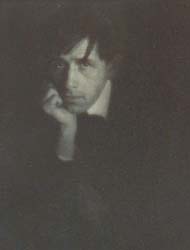
Clarence Hudson White
NAME: Clarence Hudson White
BORN: April 8, 1871
COMMUNITY AFFILIATIONS:
born...West Carlisle, Ohio
family moved...Newark, Ohio (Licking County)
OCCUPATION: educator, photographer
DIED: July 1925 (while traveling in Mexico)
FAST FACTS:
As a yougster, White's father relocated the family to Newark, Ohio to take a position at Fleek & Neal. Clarence would later take work for the same company as a bookkeeper.
White had no formal education as a photographer. He was completely self-taught. He supported his own family on a meager salary, working six days a week, eleven hours a day. Indeed, he struggled to find the time and resources for his photographic interests. In general, he could only afford two photographic plates a week.
His compositions were bold in their use of light. He wasn't afraid to point his camera right into the sun, or into the deep shadows. The stunning effects he achieved often garnered praise from the art world.
The city of Newark and its inhabitants nurtured White's creativity. Local residents volunteered to pose for him, sometimes for hours on end, often starting before dawn.
In 1898, White organized the Newark Camera Club. In 1899, the club held a major show along with a catalog featuring the works of many major American photographers. The catalog was the first of its kind. The Newark Camera Club achieved world renown by the turn of the century.
White resigned from his bookkeeping job in 1904 in order to focus on photography full time, travelling the Midwest executing portraits.
He and his family relocated to New York in 1906. In 1907, he started teaching photography at Columbia University. Eventually, he opened his own school in Maine, the Clarence H. White School of Modern Photography (aka Seguinland School of Photography). Artist and friend Max Weber was a faculty member. White and Weber later co-founded another school in New York around 1914.
White helped to educate and inspire an entire generation of photographers, including Karl Struss, Dorthea Lange, and Ralph Steiner.

